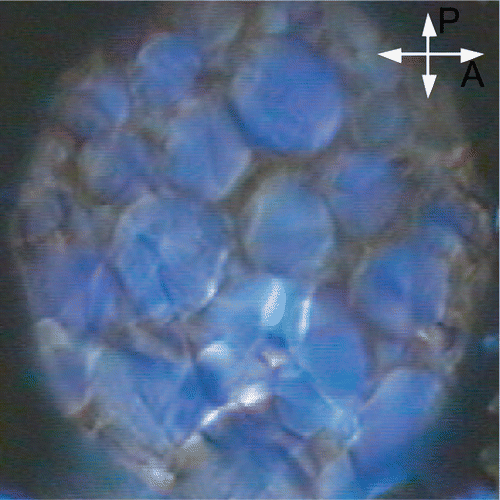Figures & data
Geometrical model of blue phases involving double twist cylinders and a network of disclination lines [Citation5].
![Geometrical model of blue phases involving double twist cylinders and a network of disclination lines [Citation5].](/cms/asset/09fa4689-bc25-4ba3-a4ae-8f2e3efcd0d2/tlcy_a_9612380_o_lcy31529_o_-1.jpg)
Sketch of the helical structure of the TGB A phase [Citation6].
![Sketch of the helical structure of the TGB A phase [Citation6].](/cms/asset/d37768a8-9771-4b5a-8978-21fb8308fd41/tlcy_a_9612380_o_lcy31529_o_-2.jpg)
Typical differential scanning calorimetry thermograms in the temperature range of smectic blue phases performed by heating and by cooling at 0.2°C/min [Citation10].
![Typical differential scanning calorimetry thermograms in the temperature range of smectic blue phases performed by heating and by cooling at 0.2°C/min [Citation10].](/cms/asset/ba41068e-df0b-4ba5-b5a0-1e27b9254b84/tlcy_a_9612380_o_lcy31529_o_-3.jpg)
Birefringence of the BPSm2 phase observed in transmission by polarizing microscopy. The thickness of the sample is 100 microns.

BPSm1 phase observed in transmission by polarizing microscopy. BPSm1 phase is optically isotropic, which shows a cubic symmetry, and the blue colour is due to its optical activity. The sample is 100 microns thick.

Figure 6. Optical activity as a function of wavelength for BPSm
A
1 (14BTMHC; T=72.8°C). The solid line is a fit to
![Figure 6. Optical activity as a function of wavelength for BPSm A 1 (14BTMHC; T=72.8°C). The solid line is a fit to Display full size where ρ is the optical activity, λ=2π/k is the wavelength of the light (k being the wavevector of the light), and λ 0=nP (P being the lattice parameter and n the average refractive index) [Citation16].](/cms/asset/7637d8c8-9d28-4fdd-918c-7582d43c1feb/tlcy_a_9612380_o_lcy31529_o_-6.jpg)
Experimental and schematic view of BPSm2 monocrystals having almost the same orientation floating in the isotropic supercooled BPSm3 and observed along a pseudothreefold axis in transmission between crossed polarizers [Citation18]. The white cross represents the projection (or the normal direction) of the optical axis in the observation plane.
![Experimental and schematic view of BPSm2 monocrystals having almost the same orientation floating in the isotropic supercooled BPSm3 and observed along a pseudothreefold axis in transmission between crossed polarizers [Citation18]. The white cross represents the projection (or the normal direction) of the optical axis in the observation plane.](/cms/asset/8a9a0e15-3ec6-4e42-beb1-94a83de6e0d7/tlcy_a_9612380_o_lcy31529_o_-7.jpg)
Orthorhombic dodecahedral crystal habit formed by four (100) facets (labelled 3 and 6) and eight (111) facets (labelled 1, 2, 4, and 5) accounting for the experimentally observed monocrystals of the BPSm2 phase [Citation18]. For this model, the parameters of the unit cell are a=1, b=0.82, and c=0.58 and the optical axis is located perpendicular to the normal of the facet labelled 3.
![Orthorhombic dodecahedral crystal habit formed by four (100) facets (labelled 3 and 6) and eight (111) facets (labelled 1, 2, 4, and 5) accounting for the experimentally observed monocrystals of the BPSm2 phase [Citation18]. For this model, the parameters of the unit cell are a=1, b=0.82, and c=0.58 and the optical axis is located perpendicular to the normal of the facet labelled 3.](/cms/asset/acab86ce-ebce-4082-a0b0-e3d3e8a58199/tlcy_a_9612380_o_lcy31529_o_-11.jpg)
Experimental X-ray scattering patterns of BPSm2 monodomains. Parts of the ring with higher intensity (labelled (I)), where the smectic order is enhanced, correspond to the Bragg peaks, and parts with lower intensity are marked (II). The layer spacing and the correlation lengths of the smectic order are also indicated [Citation Citation14, 19].
![Experimental X-ray scattering patterns of BPSm2 monodomains. Parts of the ring with higher intensity (labelled (I)), where the smectic order is enhanced, correspond to the Bragg peaks, and parts with lower intensity are marked (II). The layer spacing and the correlation lengths of the smectic order are also indicated [Citation Citation14, 19].](/cms/asset/b8abc5e6-5276-439f-82f9-86ec773e1a3a/tlcy_a_9612380_o_lcy31529_o_-12.jpg)
Geometrical model of a smectic double twist cylinder giving rise to the experimental smectic peaks (called region (I) in ). In this picture, the surfaces represent the smectic layers and the black lines wrapping around the cylinder represent the screw dislocations. However, smectic order persists between cylinders and gives rise to the continuous smectic ring (region labelled (II) in ) [Citation20].
![Geometrical model of a smectic double twist cylinder giving rise to the experimental smectic peaks (called region (I) in figure 12). In this picture, the surfaces represent the smectic layers and the black lines wrapping around the cylinder represent the screw dislocations. However, smectic order persists between cylinders and gives rise to the continuous smectic ring (region labelled (II) in figure 12) [Citation20].](/cms/asset/022a2998-c8de-4cc6-b02c-d4f347ad0e5a/tlcy_a_9612380_o_lcy31529_o_-13.jpg)
Faceted monodomain of the BPSm2 phase exhibiting four large and two small facets [Citation18].
![Faceted monodomain of the BPSm2 phase exhibiting four large and two small facets [Citation18].](/cms/asset/0b7dd612-736d-4666-a77d-4844a459fe37/tlcy_a_9612380_o_lcy31529_o_-8.jpg)
BPSm2 monocrystal floating in the supercooled BPSm3 and observed along a two-fold axis in transmission between crossed polarizers [Citation18].
![BPSm2 monocrystal floating in the supercooled BPSm3 and observed along a two-fold axis in transmission between crossed polarizers [Citation18].](/cms/asset/7d3d3613-e5c0-4aa0-b92d-0e38f02ba9f6/tlcy_a_9612380_o_lcy31529_o_-9.jpg)
Crystal shape of BPSm2 which stays dark for all the positions of the crossed polarizers [Citation18]. The optical axis is then perpendicular to the plane of the figure. An angle of about 120° is observed on this picture.
![Crystal shape of BPSm2 which stays dark for all the positions of the crossed polarizers [Citation18]. The optical axis is then perpendicular to the plane of the figure. An angle of about 120° is observed on this picture.](/cms/asset/708ae0f9-7053-45cc-955c-ef698fbd3e6b/tlcy_a_9612380_o_lcy31529_o_-10.jpg)